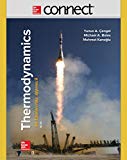
Concept explainers
(a)
The temperature and relative humidity of the air when it leaves the heating section.
(a)
Answer to Problem 137RP
The temperature is
Explanation of Solution
As the process is a steady flow and thus the mass flow rate of dry air remains constant during the entire process.
Here, the mass flow rate of air at inlet is
The amount of moisture in the air remains constant as it flows through the heating section as process involves no dehumidification or humidification.
Here, specific humidity at state 1 and 2 is
Express initial pressure of vapor.
Here, relative humidity at state 1 is
Express initial humidity ratio.
Here, pressure at state 1 is
Express initial enthalpy.
Here, specific heat at constant pressure is
Express specific volume at state 1.
Here, gas constant of air is
Express pressure vapor at state 3.
Here, relative humidity at state 3 is
Express humidity ratio at state 3.
Here, pressure at state 3 is
Express enthalpy at state 3.
Here, specific heat at constant pressure is
Express enthalpy at state 2.
Express enthalpy at state 2 to obtain the temperature at heating section.
Here, temperature at heating section is
Express pressure of water vapor at state 2.
Here, saturation pressure at temperature at leaving section is
Express relative humidity at heating section.
Here, pressure at state 2 is
Conclusion:
Refer Table A-4, “saturated water-temperature table”, and write the saturation pressure and initial specific enthalpy saturated vapor at temperature of
Substitute
Substitute
Substitute
Refer Table A-2, “ideal-gas specific heats of various common gases”, and write the properties of air.
Substitute
Substitute
Refer Table A-4, “saturated water-temperature table”, and write the saturation pressure and initial specific enthalpy saturated vapor at temperature of
Substitute
Substitute
Substitute
Substitute
Substitute
Hence, the temperature of the air when it leaves the heating section is
Substitute
Refer Table A-4, “saturated water-temperature table”, and write the saturation temperature or exit temperature at temperature of
Write the formula of interpolation method of two variables.
Here, the variables denote by x and y is temperature and exit or saturation temperature respectively.
Show the saturation pressure corresponding to temperature as in Table (1).
|
Exit temperature |
Saturation pressure |
| 30 | 4.2469 |
| 33.1 | |
| 35 | 5.6291 |
Substitute
Substitute
Substitute
Hence, the relative humidity of the air when it leaves the heating section is
(b)
The rate of heat transfer in the heating section.
(b)
Answer to Problem 137RP
The rate of heat transfer in the heating section is
Explanation of Solution
Express the rate of heat transfer in the heating section.
Here, mass flow rate of air is
Express mass flow rate of air.
Here, volume flow rate at inlet is
Conclusion:
Substitute
Substitute
Hence, the rate of heat transfer in the heating section is
(c)
The rate of water added to air in the evaporative cooler.
(c)
Answer to Problem 137RP
The rate of water added to air in the evaporative cooler is
Explanation of Solution
Express the rate of water added to air in the evaporative cooler.
Conclusion:
Substitute
Hence, the rate of water added to air in the evaporative cooler is
Want to see more full solutions like this?
Chapter 14 Solutions
Connect 1-Semester Access Card for Thermodynamics: An Engineering Approach
- Determine the mass and enthalpy of 0.15 m3 of wet steam at a pressure of 4 bar and dryness fraction 0.8arrow_forwardWhich process requires more energy: completely vaporizing 100 kg of saturated liquid water at 1atm pressure or completely vaporizimg 10 kg of saturated liquid water at 5 atm pressure?arrow_forwardWhat is the heat transfer rate required to condense the water, cool the water vapor, and cool the air?arrow_forward
- What do you mean by specific heat at constant pressure?arrow_forwardClassify internal combustion engines taking various factors into consideration. What is athermodynamic temperature scale or absolute temperature scale? Explain theestablishment of such a scale.arrow_forwardIn your own words, answer the following questions: 1. What is the dew-point temperature? 2. How does the air motion in the vicinity of the human body affect human comfort? 3. What is the difference between dry air and atmospheric air? 4. Describe the difference between mass fraction and mole fractionarrow_forward
- How much much heat must be supplied to water at 180 degrees celcius to make 1 kg of wet steam at 9000 kpa , having a dryness fraction of 80% ? .arrow_forwardWhat is a blackbody? How do real bodies differ from a blackbody?arrow_forwardDefine T-v diagram for the heating process of water at constant pressure.arrow_forward
- Determine the lower heating value of methane if its higher heating value (HHV) is 23,880Btu/lbmarrow_forwardCalculate the partial pressure of oxygen in the air at 100 kPa if nitrogen has a partial pressure of 82 kPa and carbon dioxide and water combined have a partial pressure of 0.77 kPa.arrow_forwardIs it possible to compress an ideal gas isothermally in an adiabatic piston–cylinder device? Explainarrow_forward
 Refrigeration and Air Conditioning Technology (Mi...Mechanical EngineeringISBN:9781305578296Author:John Tomczyk, Eugene Silberstein, Bill Whitman, Bill JohnsonPublisher:Cengage Learning
Refrigeration and Air Conditioning Technology (Mi...Mechanical EngineeringISBN:9781305578296Author:John Tomczyk, Eugene Silberstein, Bill Whitman, Bill JohnsonPublisher:Cengage Learning
